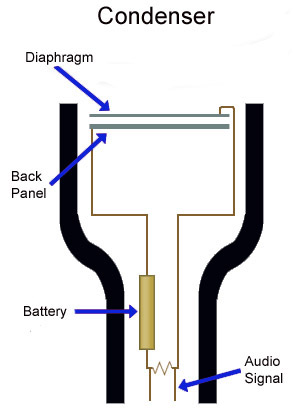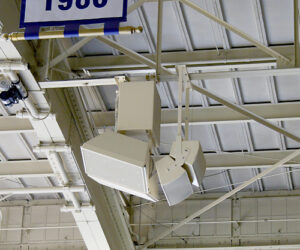In this installment of Real World Gear, we look at handheld condenser microphones, one of the three basic types of microphones – dynamic, ribbon and condenser.
Condenser mics (or capacitor mics as they’re called in the U.K.) place a thin plastic diaphragm with a coating of vaporized metal in close proximity to a backplate, and apply a charge across them.
Sound causes the diaphragm to vibrate, and as their distance varies, so does capacitance, causing current and resulting changes in voltage.
The diaphragm’s low mass provides extended frequency response over dynamic mics, offset by the need for phantom power and a susceptibility to high humidity.
Originally condenser mics were large, fragile and used mostly in recording or broadcast.
In the 1960s, transistors replaced tubes to produce small diaphragm condensers, and early live sound vocal condensers were often pencil condensers with blast grills added.
A decade later, the Shure SM86 and AKG C535 incorporated integral windscreens and electret capsules.
With advances in surface-mount technology, active microphone circuitry has become smaller, better, less expensive and more rugged, allowing high-quality condensers of both types to be manufactured as handheld microphones.
Condenser mics are further divided into electrets and true condensers, which are technically referred to as “self-biased” and “externally-biased.” Electret designs feature a permanent electrostatic charge that eliminates the need for an externally applied bias, but they still require voltage to power the on-board pre-amp electronics.
The permanent charge is applied to the diaphragm by laminating a layer of plastic, increasing the diaphragm’s thickness and mass. Alternately, back-electret mics laminate the backplate, increasing stability and reducing the diaphragm’s mass – hence their popularity.
Many high-quality mics are electret designs, including all DPA models, the Shure KSM32 and the newer AKG C451B and C414-XLS. Thanks to modern manufacturing techniques the performance of electret condensers can rival externally biased condensers.
Consequently it’s not unusual to find premium electret condensers simply specified as “pre-polarized” and “requiring” 48 volts of phantom power, though they’re actually back-electrets.
Handheld mics are susceptible to handling noise, so shock-mounting the capsule is a requirement for an element whose response can start around 20 Hz.
Additionally, handheld mics suffer from proximity effect when held close to the mouth, so high-pass filters are often required to reduce exaggerated boominess when held close to the mouth as well as to further attenuate handling noise. Multi-stage blast grills decrease wind, breath, pops and plosives, while reducing the adverse effects of moist breath on the capsule.
Microphone sensitivity is often expressed as the voltage in millivolts (mV) generated from a specific sound pressure, usually 94 dB or 1 Pascal (Pa), and is referenced to 1,000 Hz. By converting sensitivity from mV/Pa to dBV, various mics can be easily compared, with larger negative numbers being less sensitive (producing less voltage for a given input), and relative differences in gain easily compared in dB.
Most condenser mics provide more output than their dynamic cousins due to their active electronics. For example, at -54.5 dBV, a Shure SM58 has lower sensitivity than every condenser mic in this feature but one.
Today’s live performance handheld condensers can provide fidelity matching the studio sound of contemporary artists. Here we look at 16 handheld condenser vocal mics.
Mark Frink is Editorial Director of Live Sound International.

















